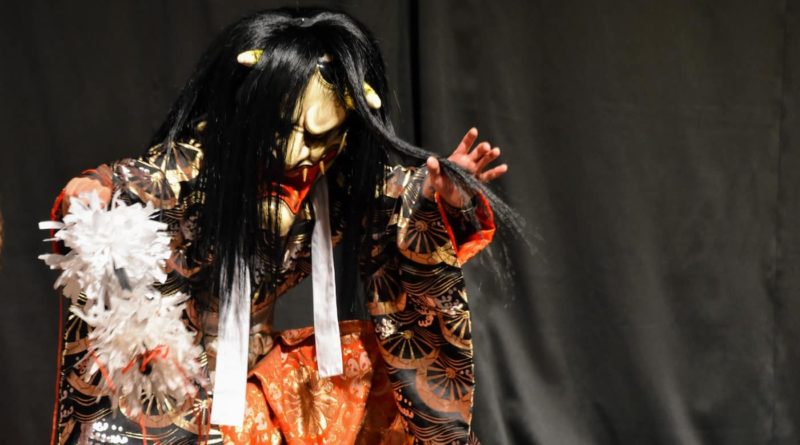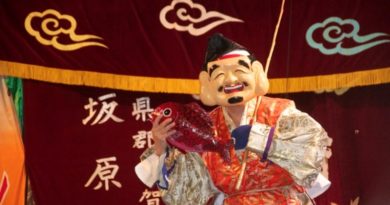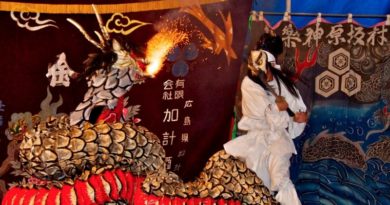Lost and Found in Translation: Bringing Kagura to an International Audience
I remember the first time I saw Kagura. It was at a local autumn festival that I happened across as I was leaving work. Behind the busy street lay a small shrine I had barely noticed, lit up with vendors selling popular matsuri favorites and crowded with people. But it wasn’t so much the lights and the crowd that drew me as it was the pounding rhythm of the taiko drums and the spritely flute that echoed from the narrow alleyway all the way down the block and beyond. Behind the row of vendors was a large makeshift stage with deep purple curtains, and in front of that stage was a crowd of forty or fifty people sitting on blankets, blue tarps, or camping chairs, all huddled up against the chilly night.
Standing in the back of that crowd, I watched the players on the stage transfixed in awe. Costumes of bright orange and red and yellow winked and flashed under the lights each time they twirled across the stage. It was like watching a Noh play performed at triple speed, like Kabuki for the masses, not the aristocracy. Even though I couldn’t understand what was being said (ancient Japanese not being my strong suit), I remember being utterly charmed and captivated by the pageantry and colorful theatrics. The music and the magic of Kagura stuck with me long after the play was over.
It was by nothing more than a good turn of fate that I ended up translating Kagura for An Evening of Kagura, a cultural event sponsored by the Hiroshima Prefectural Government aimed at an international audience. Each month, a different Kagura troupe performs a traditional Kagura play with English subtitles, and then there’s a question and answer session followed by a photo session onstage with Kagura players, costumes, and masks. It’s a wonderful and rare opportunity to see Kagura, traditionally performed in the fall, year-round. I was asked at first to look over and check the English translations done by a Japanese translator, but it quickly progressed into being asked to translate the plays directly.
As I mentioned before, ancient Japanese is not my strong suit. It’s the kind of language that makes Shakespearean English look as simple as pig-latin. Luckily for me, the scripts come with both the ancient Japanese text as well as a rough translation into modern Japanese. Looking at both of these texts provides a more complete picture of what the characters are trying to say and, more importantly, how they’re saying it.
Translation is a funny thing: translate something too literally and it loses its character and becomes flat. But take the translation too far and suddenly you’re not being true to the text. It’s all about walking a fine line between word-for-word translation and literary interpretation. My method is to start with a flat translation for a line of dialogue and build from there, switching out words or phrases until I find one that clicks for me. And sometimes, it just won’t click. Half of my process includes a lot of staring at the screen, frantically pressing backspace while mumbling the same line in Japanese over and over again. Thankfully, translation is solitary work so no one but my laptop has to see my half-crazed ramblings. It can take up to four hours to properly finish a play, read it over, correct any mistakes and send the finished version off.
There is something intensely rewarding about translating a form of entertainment. Up until now, the bulk of my translation work has been articles or interviews, which leave very little room for creativity or the dramatic. But with Kagura, I’m very generously given free reign to indulge in the theatrical and play up the conflicts and drama that make Kagura so very good. It is, however, no easy task trying to find English correspondents to words like the names of demons and monsters or military ranks which so frequently come up. Instead of creating new names, I often try to incorporate the original Japanese words, explaining their meaning in the pamphlet handed out at the door or somewhere in the play itself. Then there are times when I watch the play and find a disconnect between my interpretation of the text versus the performance itself. Plot twist: I actually didn’t see any of the plays before translating them, and that’s something which I would have done differently if I could go back to when I started this job. When I find discrepancies or differences in nuances, I try and go back and fix the original script so that next time, things will go more smoothly. Other times, technical difficulties such as timing or software errors, faulty connections, the use of old, unedited text, what-have-you, disrupt the Kagura experience. As a translator, it’s very hard to watch your work suddenly cut out, leaving the audience in the dark. It’s also hard to see text that had previously been fixed not get used for whatever reason.
But when things go smoothly and the timing is perfect, it’s a proud moment not just for me, but for the event on the whole. Watching the crowd engage with the story on a level that I had never been able to until now — there’s no better feeling.
Aside from the plays, I’m also in charge of the summaries of each play that you can find in the welcome packet, as well as the profiles of all of the Kagura troupes, and the English homepage. I’m also the one who came up with the title An Evening of Kagura with the intention of bringing an air of culture and artistry that this event most certainly deserves.
Much like the event itself, I’m also constantly growing and evolving as a translator, as long-time regular Kagura-goers can certainly attest to. It is such an honor to be a part of the rich legacy of the art of Kagura, and to help bring it to an international audience. I want them to feel that same awe and wonder that I felt the very first time I happened across that autumn festival, and for the magic to linger in their memories long after they leave the show.
For more information about An Evening of Kagura, check out their homepage and follow them on Facebook.





